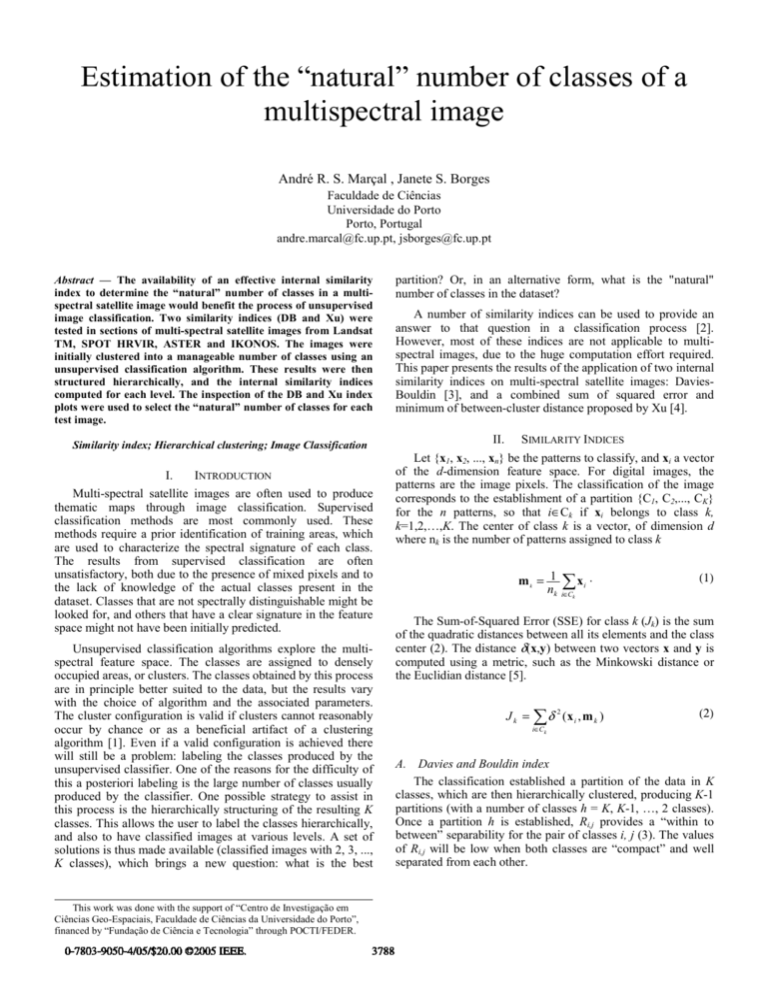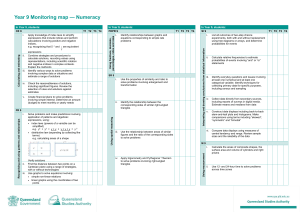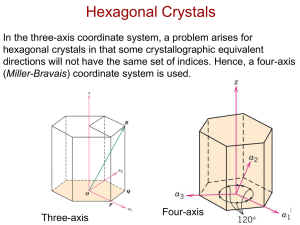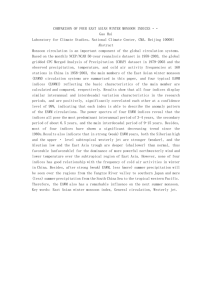Estimation of the “natural” number of classes of a multispectral image
advertisement

Estimation of the “natural” number of classes of a
multispectral image
André R. S. Marçal , Janete S. Borges
Faculdade de Ciências
Universidade do Porto
Porto, Portugal
andre.marcal@fc.up.pt, jsborges@fc.up.pt
Abstract — The availability of an effective internal similarity
index to determine the “natural” number of classes in a multispectral satellite image would benefit the process of unsupervised
image classification. Two similarity indices (DB and Xu) were
tested in sections of multi-spectral satellite images from Landsat
TM, SPOT HRVIR, ASTER and IKONOS. The images were
initially clustered into a manageable number of classes using an
unsupervised classification algorithm. These results were then
structured hierarchically, and the internal similarity indices
computed for each level. The inspection of the DB and Xu index
plots were used to select the “natural” number of classes for each
test image.
INTRODUCTION
Multi-spectral satellite images are often used to produce
thematic maps through image classification. Supervised
classification methods are most commonly used. These
methods require a prior identification of training areas, which
are used to characterize the spectral signature of each class.
The results from supervised classification are often
unsatisfactory, both due to the presence of mixed pixels and to
the lack of knowledge of the actual classes present in the
dataset. Classes that are not spectrally distinguishable might be
looked for, and others that have a clear signature in the feature
space might not have been initially predicted.
Unsupervised classification algorithms explore the multispectral feature space. The classes are assigned to densely
occupied areas, or clusters. The classes obtained by this process
are in principle better suited to the data, but the results vary
with the choice of algorithm and the associated parameters.
The cluster configuration is valid if clusters cannot reasonably
occur by chance or as a beneficial artifact of a clustering
algorithm [1]. Even if a valid configuration is achieved there
will still be a problem: labeling the classes produced by the
unsupervised classifier. One of the reasons for the difficulty of
this a posteriori labeling is the large number of classes usually
produced by the classifier. One possible strategy to assist in
this process is the hierarchically structuring of the resulting K
classes. This allows the user to label the classes hierarchically,
and also to have classified images at various levels. A set of
solutions is thus made available (classified images with 2, 3, ...,
K classes), which brings a new question: what is the best
This work was done with the support of “Centro de Investigação em
Ciências Geo-Espaciais, Faculdade de Ciências da Universidade do Porto”,
financed by “Fundação de Ciência e Tecnologia” through POCTI/FEDER.
0-7803-9050-4/05/$20.00 ©2005 IEEE.
A number of similarity indices can be used to provide an
answer to that question in a classification process [2].
However, most of these indices are not applicable to multispectral images, due to the huge computation effort required.
This paper presents the results of the application of two internal
similarity indices on multi-spectral satellite images: DaviesBouldin [3], and a combined sum of squared error and
minimum of between-cluster distance proposed by Xu [4].
II.
Similarity index; Hierarchical clustering; Image Classification
I.
partition? Or, in an alternative form, what is the "natural"
number of classes in the dataset?
3788
SIMILARITY INDICES
Let {x1, x2, ..., xn} be the patterns to classify, and xi a vector
of the d-dimension feature space. For digital images, the
patterns are the image pixels. The classification of the image
corresponds to the establishment of a partition {C1, C2,..., CK}
for the n patterns, so that i∈Ck if xi belongs to class k,
k=1,2,…,K. The center of class k is a vector, of dimension d
where nk is the number of patterns assigned to class k
mk = 1
nk
∑x
i
.
(1)
i∈Ck
The Sum-of-Squared Error (SSE) for class k (Jk) is the sum
of the quadratic distances between all its elements and the class
center (2). The distance δ(x,y) between two vectors x and y is
computed using a metric, such as the Minkowski distance or
the Euclidian distance [5].
Jk =
∑δ
2
(x i , m k )
(2)
i∈Ck
A. Davies and Bouldin index
The classification established a partition of the data in K
classes, which are then hierarchically clustered, producing K-1
partitions (with a number of classes h = K, K-1, …, 2 classes).
Once a partition h is established, Ri,j provides a “within to
between” separability for the pair of classes i, j (3). The values
of Ri,j will be low when both classes are “compact” and well
separated from each other.
3788
Ri , j =
J j / n j + Ji / ni
δ (m j , m i )
(3)
The Davies-Bouldin (DB) index of a partition h is the
average of the highest Ri,j of each class (4). The lowest the
value of DB(h) the better is the separability between classes,
and therefore the better the partition h.
DB(h) =
K
1
Rh , Rh=Max{ Ri,j , ∀i≠j}
K −1 ∑
h=2
(4)
algorithm ClusterData [7]. The synthetic data is presented in
Fig.1, as well as the data clustered in 5, 7 and 10 classes.
The DB and the Xu indices were computed for each
partition. A plot of both indices is presented in Fig. 2. The Xu
index clearly points to a solution for k=7, with a second choice
for k=5 but clearly less favored. On the contrary, the DB index
does not distinguish significantly between the solutions with 5
and 7 classes, with only a very slight advantage towards k=5.
The combined analysis of both indices would suggest a choice
of 7 classes as the most reasonable in this case.
The DB index was used with the Minkowski distance [3]
and the Euclidian distance [5]. A modification of the DB index
is to use the Mahalanobis distance [6] as the metric in (2).
However, the results were not significantly different that those
using the Euclidian distance.
B. Xu index
The Ward distance (5) is used to evaluate the distance
between two clusters i and j [4].
δ ijw =
ni × n j
ni + n j
× mi − m j
(5)
A dissimilarity measure, in terms of the Minimum of
Between-Cluster Distances (MBCD), can be defined for a
partition with k classes (6). Both SSE and MBCD alone are
insufficient to establish a criterion for the best partition.
However, the two can be used combined to form an index [4].
M = min i < j δ ijw , i,j = 1,2,…, k
Figure 1. Synthetic data (top left) clustered in 5 classes (top right), 7 classes
(bottom left) and 10 classes (bottom right).
(6)
The index proposed by Xu, E(h), evaluates the level h of
the hierarchical structure, comparing the SSE and MBCD of
this level with the proceeding. The index E(h) is computed
using (7), where J(h) is the sum of the Jk for all clusters of
partition h.
E (h) =
M (h) − M ( h + 1)
J (h) − J (h + 1)
(7)
When plotting the index E as a function of h, a significant
maximum of E(h) should be expected to appear at level h*,
where lie h* natural groupings or clusters [4].
C. Example with synthetic data
The performance of the DB and Xu indices was verified
using synthetic data. An example of application of both indices
to a synthetic data set is presented in this section. A total of 100
two-dimensional patterns were generated using 8 Gaussian
curves, with a standard deviation of 0.04. The data was
classified in k classes (with k=2, 3, ..., 12), using MATLAB
0-7803-9050-4/05/$20.00 ©2005 IEEE.
3789
Figure 2. Davies-Bouldin index (top) and Xu index (bottom) plots for the
synthetic data of Fig.1.
3789
III.
RESULTS
Four satellite multi-spectral images were selected to
evaluate the performance of the DB and Xu similarity indices.
These images are small sections of 512 by 512 pixels, and are
presented in Fig. 3 as false color composites, with the near
infrared in the green channel. Image I is from Landsat TM and
covers an agricultural region. Image II is from SPOT HRVIR,
of an estuary and the surrounding wetlands. Image III is from
the ASTER sensor and covers an area mainly with forest, with
a river and small urban parts. Image IV is an IKONOS multispectral image of an urban area.
Figure 4.
DB index (top) and Xu index (top) applied to test image I.
B. Test image II – SPOT HRVIR
Test image II has 4 spectral bands with a pixel size of 20m.
The plots for the DB index and the Xu index for this image are
presented in Fig. 5. The Xu index first favors a partition in 27
classes, followed by a partition in 4 classes. There are two
other local maxima, but not very prominent. The DB index is
consistent with both choices (for h=4 or h=27), although it also
favors h=13 or h=17. But combining the information from both
indices, the best solutions are for h=4 and h=27.
Figure 3. Test images: I – Landsat TM (top left), II – SPOT HRVIR (top
right), III – ASTER (bottom left), IV – IKONOS (bottom right)
Each test image was classified using the algorithm
ISODATA implemented on the software PCI Geomatics [8].
The same set of parameters was used throughout, including the
range of classes allowed (20-40). In all for cases the classifier
converged with a solution of more than 30 classes. The
classification results were hierarchically structured, using the
Euclidian distance metric between the class centers (mk) as the
agglomerative criterion. A total of 29 classified images (with
30, 29, ..., 2 classes) were available from each test image, and
were used to apply the DB index and the Xu index.
A. Test image I – Landsat TM
Test image I has 6 spectral bands with a pixel size of 30m.
The thermal band of TM was not used due to its lower spatial
resolution. The values computed for the DB and Xu indices are
presented in Fig. 4, plotted versus the number of classes in each
partition. The Xu index has three clear maxima, pointing to
possible solutions for h=4, h=13 or h=16. The DB index is not
as convincing, but it seems to indicate that a choice of h=16
might be a wise one, as there is a local minimum at this level.
In this case there is a single value to select – a partition of the
image into 16 classes.
0-7803-9050-4/05/$20.00 ©2005 IEEE.
3790
Figure 5. DB index (top) and Xu index (top) applied to test image II.
C. Test image III – ASTER
Test image III is from ASTER, a sensor with 14 spectral
bands. However, at the best spatial resolution (15 m) only 3
bands are available. The classifier only used the first 3 bands of
ASTER. The plots for the internal similarity indices DB and
Xu are presented in Fig. 5. The Xu index has a very strong
3790
maximum for h=2, which is also the minimum for the DB
index. This is clearly a classification very “natural” from the
data perspective, as the 2 classes are water and land, which
have a very different spectral signature in the visible and nearinfrared parts of the spectrum. However, as this might not a
very useful classification from the user point of view, other
possible choices for h should be considered. Unfortunately, in
this case the 2 indices do not provide consistent indications.
The Xu index has slight maxima at h=13 and h=23. The DB
index points to h=8, h=19 and h=26. The value h=23 might be
selected by the DB index plot in a second group of candidates.
satellite image would benefit the process of unsupervised
image classification.
The method proposed here starts by clustering the multispectral image, using an unsupervised classification algorithm,
into a manageable number of classes. These are then structured
hierarchically, and the internal similarity indices proposed by
Davies and Bouldin [3] and Xu [4] are computed. Both indices
are applicable to large multi-spectral images. The DB and Xu
index plots are used to select the "natural" number of classes
from the set of classified images. The plots of the Xu index are
generally easier to interpret, as the maxima are very
distinguishable. The choice of the best number of classes from
the DB index plot is usually not so obvious. However, the
combined use of both indices can provide a choice for the
“natural” number of classes, or perhaps 2 or 3 good choices.
Figure 6. DB index (top) and Xu index (top) applied to test image III.
D. Test image IV – IKONOS
Test image IV is a section of an IKONOS multi-spectral
image, with 4 bands and a pixel size of 4m. The DB index and
Xu index plots are presented in Fig. 7. The Xu index clearly
selects two partitions as good ones: h=3 and h=8. The DB
index indication of the best number of classes is not so
obvious. The most favored seem to be h=3, h=7, h=8 and h=19.
These values include the two selected by the Xu index, which
are therefore the suitable values for this image.
IV.
CONCLUSIONS
Unsupervised classification methods have great potential
for the classification of multi-spectral satellite images, as they
permit the identification of the classes that are naturally
distinguishable in the data. One of the reasons that justify the
fact that these methods are somehow neglected for satellite
image classification is the difficulty in assessing the results
produced. A number of statistical indices have been developed
and used to assess the classification results [2], but few are
applicable to large data volumes, such as multi-spectral satellite
images. The availability of an effective internal similarity index
to determine the “natural” number of classes in a multi-spectral
0-7803-9050-4/05/$20.00 ©2005 IEEE.
3791
Figure 7. DB index (top) and Xu index (top) applied to test image IV.
REFERENCES
[1]
[2]
[3]
[4]
[5]
[6]
[7]
[8]
Jain, A. K., Murty, M. N., Flynn, P. J., “Data clustering: A review”.
ACM Computing Surveys, Vol. 31, No. 3, pp. 264-323, 1999.
Milligan, G. W. and Cooper, M. C., “An examination of procedures for
determining the number of clusters in a data set”. Psychometrika, Vol.
50, No. 2, pp. 159-179, 1985.
Davies, D. L., Bouldin, D. W., “A cluster separation measure”, IEEE
Transactions on Pattern Analysis and Machine Intelligence, Vol. 1, pp.
224-227, 1979.
Xu, S., Kamath, M. V., Capson, D. W., “Selection of partitions from a
hierarchy”, Pattern Recognition Letters, Vol. 14, No. 1, pp. 7-15, 1993.
Dubes, R. C., “How many clusters are best - an experiment”. Pattern
Recognition, Vol. 20, No. 6, pp. 645-663, 1987.
J.A. Richards and X. Jia, Remote Sensing Digital Image Analysis, 3rd
ed., Berlin, Germany, Springer-Verlag, 1999.
The MathWorks: MATLAB The Language of Technical Computing –
Using MATLAB: version 6. The MathWorks, Inc., 2000.
PCI GEOMATICS, X-Pace Reference Manual, Version 8.2, PCI
Geomatics, Ontario, Canada, 2001.
3791


![[#EXASOL-1429] Possible error when inserting data into large tables](http://s3.studylib.net/store/data/005854961_1-9d34d5b0b79b862c601023238967ddff-300x300.png)





